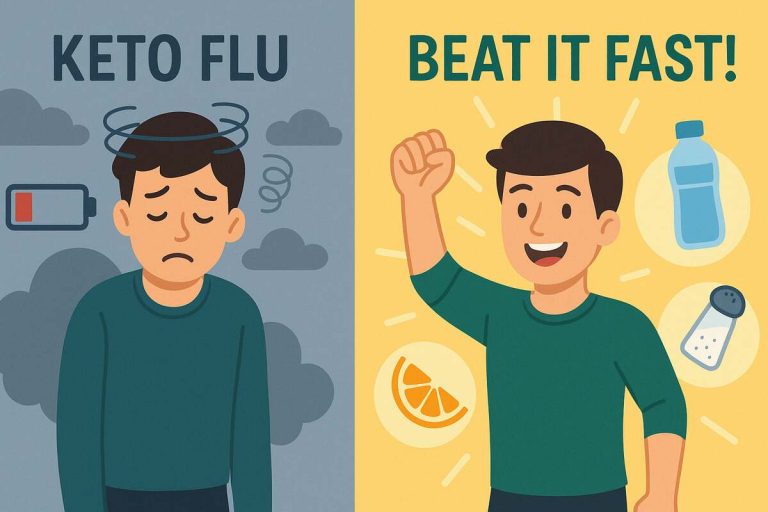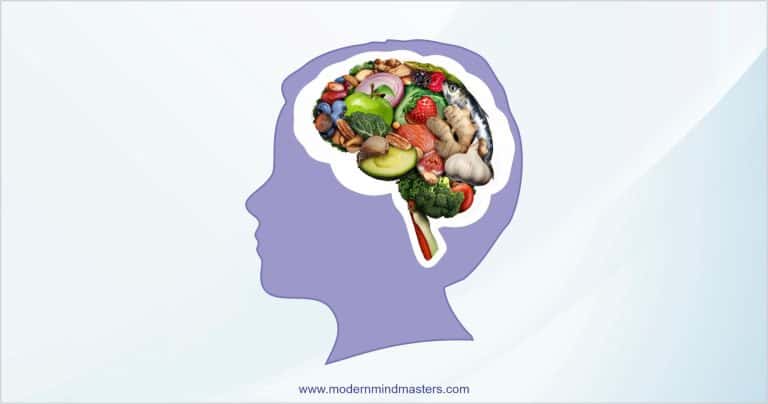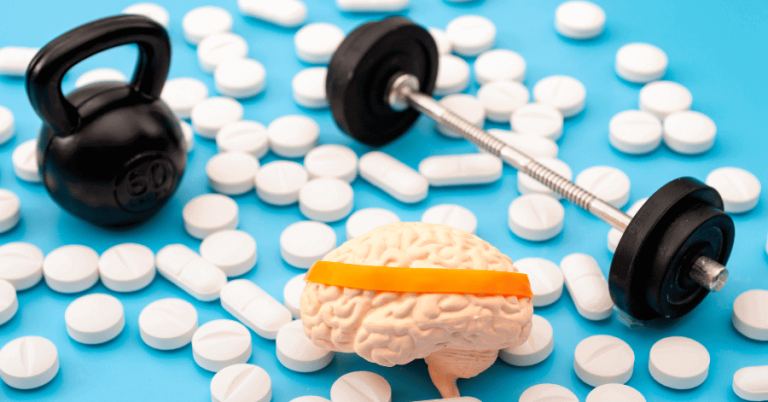If you’ve landed here, chances are you’ve already been hit by what’s commonly called the “keto flu.” But don’t worry — while it can catch many beginners off guard, it’s both avoidable with the right preparation and manageable once it starts.
In this article, we’ll break down exactly what keto flu is, why it happens, how to prevent it, and what you can do to ease the symptoms if you’re already feeling the effects (you can skip straight to how to reduce keto flu symptoms here).
The good news? Unlike the regular flu, keto flu isn’t caused by a virus or poor health. In fact, it’s often a sign that your body is making the shift from burning glucose for energy to burning fat — a transition that unlocks many of the health benefits the ketogenic diet is known for.
That said, keto flu isn’t inevitable. With a bit of knowledge and planning, you can avoid it entirely — or if you’re already in the thick of it, there are proven ways to shorten its duration and reduce its intensity. Let’s walk through everything you need to know.
What is Keto Flu?
Despite the name, keto flu isn’t actually caused by a virus — and it’s not contagious like the real flu. The term simply refers to a cluster of symptoms that some people experience when their bodies first start shifting from burning glucose (sugar) for energy to burning fat (ketones).
When you reduce your carbohydrate intake, your body’s metabolism begins a fundamental shift — one that moves you away from glucose and toward ketones as your primary fuel source, a metabolic state called ketosis. Depending on factors like your age, metabolic health, fitness level, and even the medications you take, your body can start producing ketones in as little as three days.
The problem is that even when your ketone levels rise, your cells aren’t always immediately efficient at using them for fuel. For many who have been metabolically unhealthy for quite some time, or carbohydrate dependent for many years, there’s often a short adjustment period while your body tries to remember how to run on ketones (something our ancestors would naturally have spent plenty of time doing).
For some people — especially those who are metabolically flexible (able to switch between burning glucose and ketones seamlessly), physically fit, and under forty — this transition is smooth and barely noticeable.
But for others, the switch can trigger a temporary period of discomfort, commonly known as keto flu because of its flu-like symptoms.
These symptoms usually appear within the first few days of starting keto and are transient – they don’t last forever. For most people, they resolve within a week or two as the body fully adapts to its new fat-burning state.
It’s also worth noting that for some individuals, especially those managing mental health conditions, the keto transition can temporarily affect mood or trigger heightened emotional sensitivity. This might include anxiety, mild depressive symptoms, or even bursts of high energy and restlessness (a phenomenon called hypomania). In nearly all cases, these effects are short-lived and settle down once your body completes the shift into ketosis — typically by week three.
Remember, keto flu is a sign your body is undergoing real metabolic change. While keto flu often feels terrible, unlike the regular flu, it is the first sign of real change for the better.
Keto Flu Symptoms
The symptoms of keto flu typically match those of any other kind of viral flu, including:
- Fatigue and low energy — Feeling unusually tired or sluggish, especially in the first few days.
- Brain fog — Difficulty concentrating, slow thinking, or mental fuzziness.
- Headaches — Often linked to dehydration and electrolyte imbalances as your body flushes excess water.
- Irritability or mood swings — A drop in blood sugar can leave you feeling short-tempered or emotionally off-balance.
- Muscle cramps — Often a sign your electrolytes (especially magnesium and potassium) are low.
- Dizziness or lightheadedness — Typically caused by fluid loss and lowered blood pressure during the early keto phase.
- Trouble sleeping — Changes in hormones and energy metabolism can temporarily disrupt your sleep patterns.
- Nausea or digestive issues — including diarrhea, constipation, or general stomach discomfort as your digestive system adapts.
- Heart palpitations — A racing or fluttering heartbeat, usually linked to low sodium or dehydration.
- Carbohydrate cravings — As your body switches to burning fat, you may experience strong cravings for sugar or starchy foods.
Symptoms vary depending on individual health and carbohydrate dependency. Some may not experience any symptoms at all.
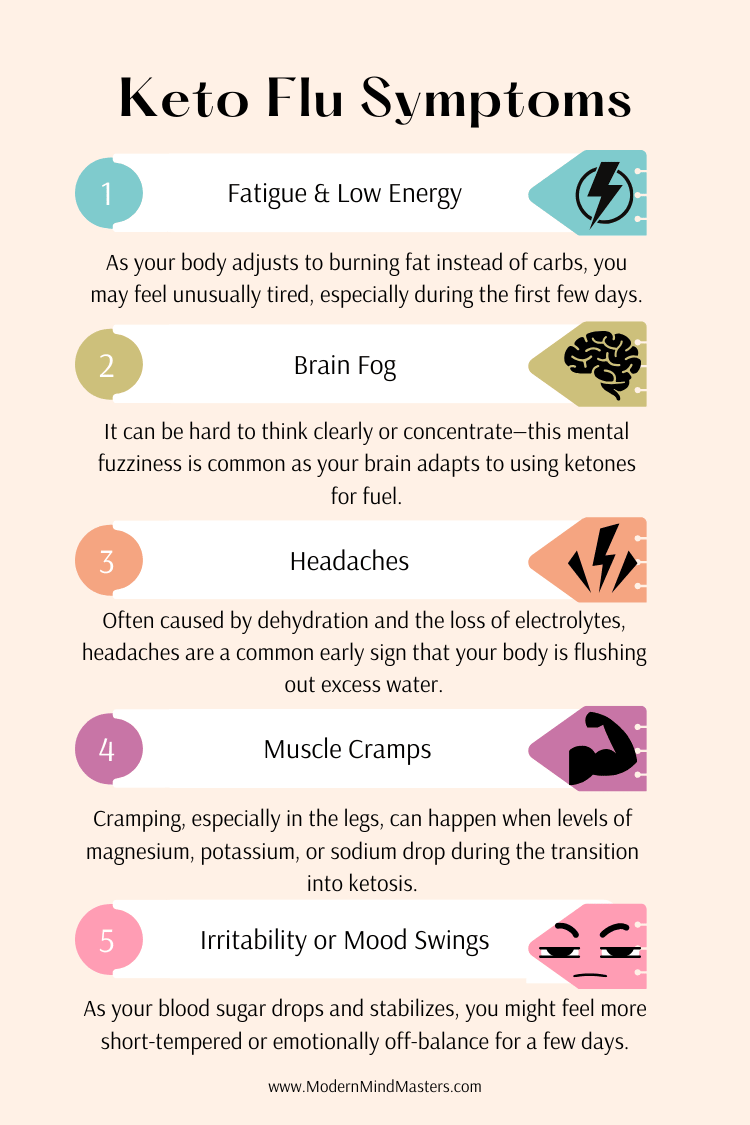
What Causes Keto Flu?
Ultimately, keto flu occurs because your body is undergoing a significant metabolic shift as it transitions from burning carbohydrates (glucose) for energy to burning fat (ketones).
In the Standard American Diet, people typically consume 250–300 grams of carbs per day (which is insane, by the way). So when you reduce your intake to under 50 grams — and for many, it will be less than 20 grams — your body experiences glycogen depletion. Glycogen is the stored form of glucose in your liver and muscles, and it gets completely used up within about 24 hours of cutting carbs.
As carbohydrate intake drops, insulin production also decreases because the body no longer needs to manage large amounts of blood sugar. Insulin’s job is to help store glucose as glycogen, so when glucose levels fall, insulin levels drop too.
Since insulin is one of the most influential and powerful hormones in the body, it’s no wonder why a rapid drop in insulin sets off a cascade of effects, including the release of stored fat to be used as energy.
What many don’t realize is that glycogen is also bound to water in the body: For every gram of glycogen stored, about 3 grams of water are also stored. When glycogen is depleted, water release contributes to rapid fluid loss that leads to dehydration, resulting in many of the common keto flu symptoms, like headaches, fatigue, and muscle cramps.
As glycogen levels continue to fall, the liver begins to convert fatty acids into ketones, which become the body’s new primary energy source. However, it takes time for your body to fully adapt to using ketones efficiently.
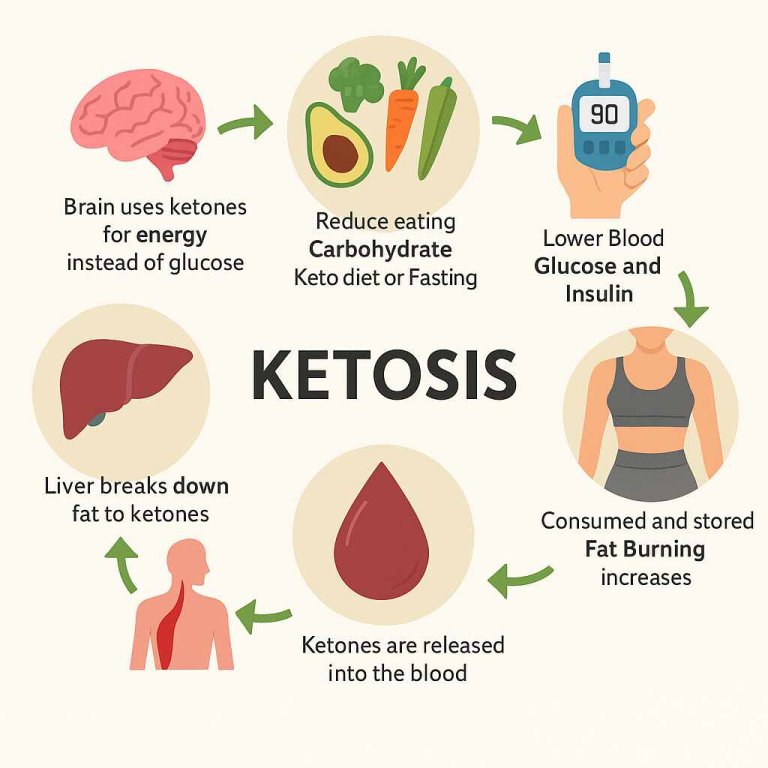
During this transition, you may experience symptoms like low energy, irritability, and fatigue. This is essentially your body “withdrawing” from its usual carb-based fuel while also learning how to burn fat for energy.
Additionally, carbohydrates play a role in the production of serotonin, a neurotransmitter that helps regulate mood. When carb intake is significantly reduced, serotonin levels can temporarily dip, which can lead to irritability, low mood, and even anxiety — all common signs of carbohydrate withdrawal. This will be worse for those who already suffer from psychiatric disorders or are on medications that affect neurotransmitters (such as SSRIs), which is why extra caution is advised for those types attempting to enter ketosis.
How Long Does Keto Flu Last?
Keto flu is typically a short-term experience, with symptoms often peaking in the first few days of your transition into ketosis. On average, most people experience symptoms for 2 to 7 days. However, the exact duration can vary depending on several factors, including how quickly your body adapts, your prior diet, and your individual metabolic state.
My first experience with keto flu occurred when I started my first water fast. Within 24 hours I had the single worst headache I’d ever experienced, extreme fatigue, and I vomited twice. While likely a mix of keto flu and caffeine withdrawal (I consumed nothing but water), my symptoms were intense but very brief – within 2 days I was perfectly fine again.
The duration and intensity of keto flu symptoms you might experience can vary widely based on a few factors:
- Carbohydrate Reduction: The faster you cut carbs, the more intense the transition might be. A gradual reduction can help ease the process.
- Metabolic Flexibility: Metabolically flexible People (i.e., those who regularly switch between burning carbs and fat) may transition to ketosis more smoothly and experience milder symptoms.
- Physical Fitness: Those who are already physically active or have a healthy metabolism may adapt more quickly to ketosis, resulting in a shorter duration of keto flu.
- Health Conditions: Underlying conditions, such as diabetes, insulin resistance, or thyroid issues, can affect how your body responds to ketosis and might extend the symptoms.
- Hydration and Electrolyte Balance: Proper hydration and maintaining electrolyte levels can significantly reduce the severity and length of keto flu symptoms.
Most keto flu symptoms begin to fade after the first week or two, though low energy can linger a bit longer. Patience is key during this phase. As your body fully adapts, symptoms typically resolve within 6 weeks.
For mental clarity and mood improvement, the first 3 days tend to be the hardest, with many people noticing significant benefits by day 4. By week 3, most individuals see considerable improvement in both energy levels and mental health. However, if you’re still struggling after 6 weeks, it might be time to troubleshoot. This could involve adjusting your carb intake, exploring a different approach, or consulting a specialist for guidance.
Is Keto Flu Dangerous?
While keto flu is rarely dangerous for moderately healthy individuals (albeit sometimes uncomfortable), things can get more complex if you’re taking medication or managing a pre-existing health condition.
Certain medications, especially those prescribed for mental health, diabetes, cholesterol, and inflammatory conditions, can affect both your ability to enter ketosis and how your body responds once you do. Some drugs can raise blood sugar, increase insulin levels, or make your cells more insulin-resistant, all of which can delay or blunt the effects of a ketogenic diet.
On the flip side, once ketosis kicks in and your metabolism starts shifting, the concentration of some medications in your blood may increase. This can lead to medication side effects becoming stronger than usual, sometimes to a dangerous degree, even if you’ve been stable on the same dosage for years.
This is especially true for psychiatric medications (antidepressants, mood stabilizers, antipsychotics), steroids (like prednisone), statins and other cholesterol-lowering medications, and diabetes medications (especially insulin or sulfonylureas)
In some cases, these medications can also increase your risk of dehydration, electrolyte imbalances, or even kidney stones when paired with a ketogenic diet.
If you fall into this category, it’s essential to approach keto, and any transition into ketosis, with extra awareness and medical supervision.
How to Avoid Keto Flu?
The best way to beat keto flu is to avoid it altogether — and the smartest strategy is not to go “cold turkey” on carbs overnight.
While jumping straight from a high-carb, Standard American Diet (SAD) to strict keto might technically get you into ketosis faster, the sudden shift can be a shock to your system. This is when keto flu symptoms tend to hit the hardest: headaches, fatigue, dizziness, mood swings, and muscle cramps are all signs that your body is struggling to adapt to the abrupt loss of its usual fuel (glucose).
A more gentle approach gives your metabolism time to adjust, so the transition into fat-burning mode is smoother and, for many people, symptom-free.
This adaption to reduced carb dependency is best achieved by engaging in a paleo-style diet for approximately 2-4 weeks before going full keto.
The paleo diet is a whole-foods-based eating plan that mimics what our ancestors might have eaten during the Paleolithic era. It focuses on nutrient-dense foods like meat, fish, eggs, vegetables, fruits, nuts, and healthy fats while eliminating grains, legumes, dairy, refined sugar, and processed foods. The goal is to eat in a way that supports stable blood sugar, reduces inflammation, and aligns with our evolutionary biology.
By doing so, we automatically reduce the amount of carbs consumed simply because of the type of foods permitted on the paleo diet. After a few weeks, you will already be adapted to lower carbohydrate intake, and the transition to keto should be much smoother, hopefully smooth enough to avoid the shock of keto flu altogether.
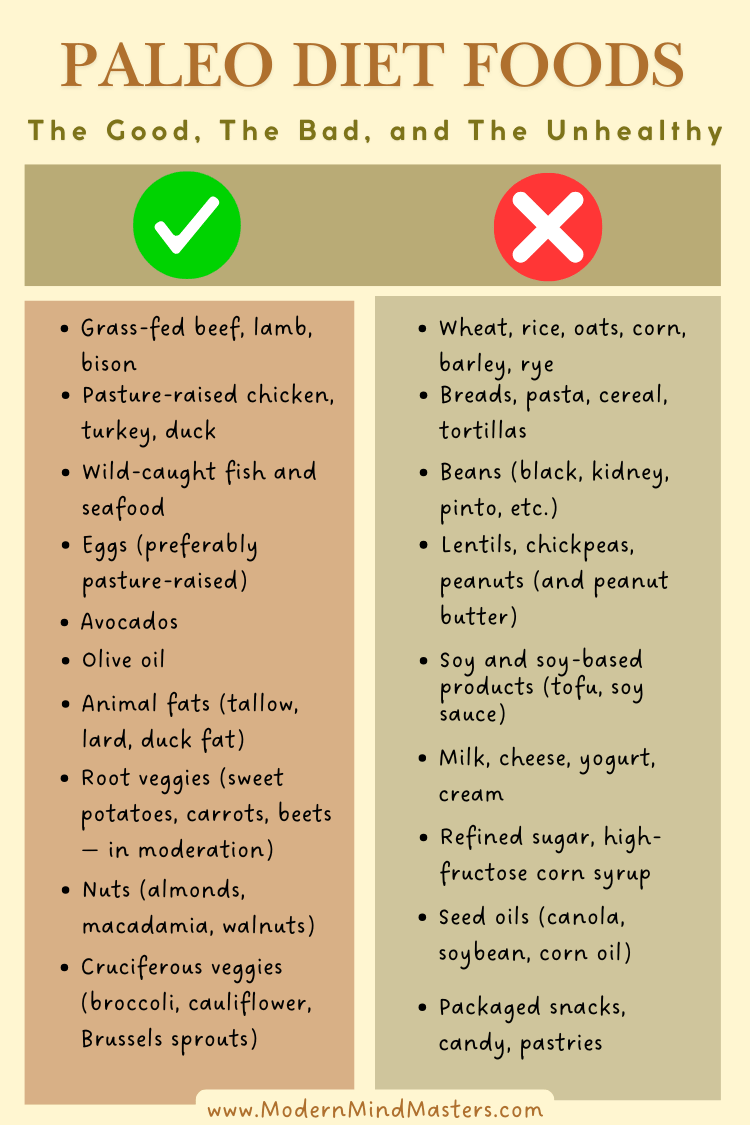
How to Reduce Keto Flu Symptoms
While preparing for keto through low carbohydrate diets like Paleo will at least reduce your keto flu symptoms, and hopefully avoid them altogether, many will experience keto flu to at least some degree.
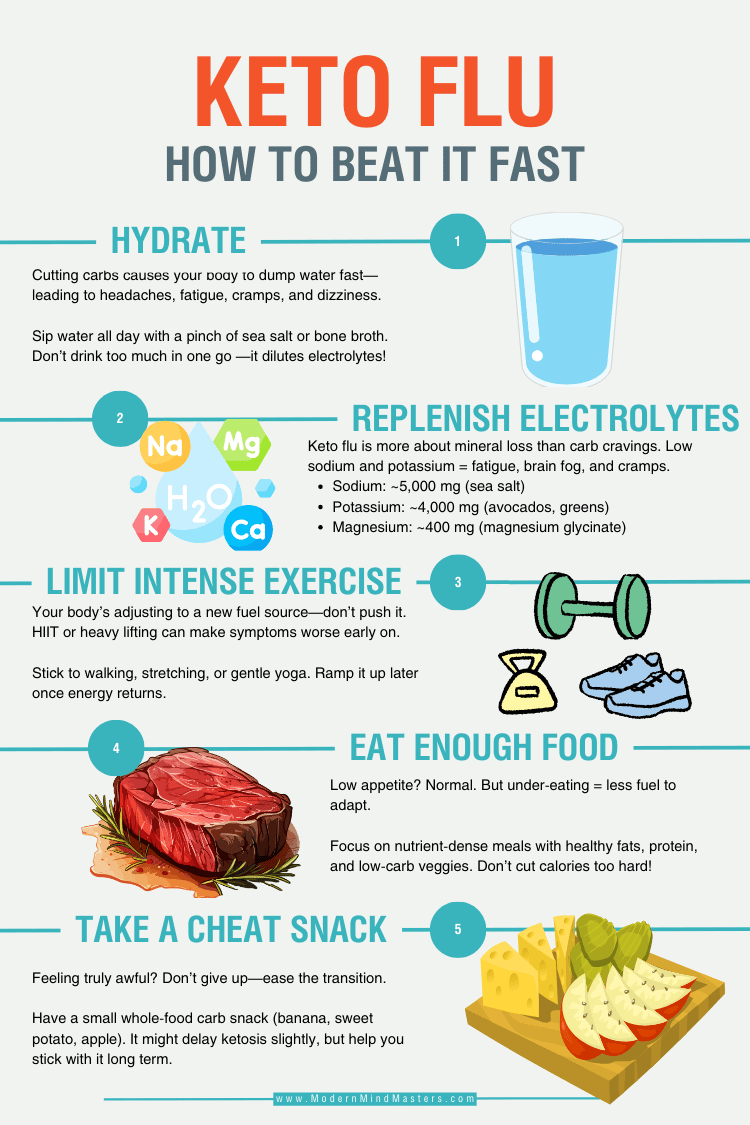
1. Hydrate, Hydrate, Hydrate
Rapid water loss is one of the first things that happens when you cut carbs. Glycogen—the storage form of glucose—holds water in your muscles and liver. As glycogen is burned off, that water is released and flushed from your body, resulting in dehydration that can lead to headaches, fatigue, muscle cramps, and dizziness – the most common Ketu flu symptoms.
Aim to drink consistently throughout the day, and add a pinch of sea salt to your water or sip on bone broth to replace sodium along with fluids. Avoid overloading on plain water without minerals—it can make symptoms worse by further diluting electrolytes.
2. Replenish Electrolytes
Keto flu is often more about mineral loss than carbohydrate withdrawal. When insulin drops, your kidneys excrete sodium and water. Your adrenal glands try to compensate by retaining sodium—but at the expense of potassium. This electrolyte imbalance can cause everything from muscle cramps and heart palpitations to brain fog and fatigue.
Daily targets during keto-adaptation:
- Sodium: ~5,000 mg (about 2½ teaspoons of sea salt)
- Potassium: ~4,000 mg (from leafy greens, avocados, salmon, or potassium salt)
- Magnesium: ~400 mg (magnesium glycinate)
You can use clean electrolyte supplements, but I prefer to avoid them and drink homemade electrolyte drinks while salting food liberally.
See this video here for how to easily make your own electrolytes (known in the fasting community as “Snake Juice”).
3. Limit Intense Exercise
While light movement like walking, stretching, or gentle yoga can help circulation and mood, avoid high-intensity exercise in the first week or two. Your body is recalibrating its fuel system, and pushing it too hard may worsen fatigue, lightheadedness, or muscle soreness. Let your energy return before ramping up workouts.
4. Eat Enough Food
One common mistake during keto-adaptation is undereating. You might be less hungry than usual—which is a good sign that insulin and blood sugar are stabilizing—but this can lead to under-fueling your body.
Prioritize nutrient-dense meals with plenty of healthy fats, protein, and low-carb vegetables if you wish (many vegetables like potatoes are high in carbs so ensure you don’t consume too many that it throws you out of ketosis). Don’t restrict calories aggressively at this stage—your body needs fuel to adapt.
5. Check for Low Blood Sugar
If symptoms persist and electrolytes don’t help, test your blood glucose. If it’s below 55 mg/dL, take 1 tablespoon of fruit juice and retest in 15 minutes. If it’s between 55–70 mg/dL and you have symptoms like nausea, shakiness, or confusion, treat it as well.
6. Take a Cheat Snack If Necessary
If you’re feeling truly awful—dizzy, depressed, anxious, or like you’re ready to quit—have a small, healthy, whole-food carbohydrate snack. A few bites of sweet potato, half a banana, a small apple, or some cooked squash can give your brain a gentle glucose boost and provide much-needed relief.
Yes, technically it may slow your entry into ketosis—but that’s a small setback compared to quitting altogether. Think of it as a strategic pause, not a failure. The goal is to reap the benefits of ketosis, not to brute force yourself through keto flu.
This journey is about long-term transformation, not short-term perfection. Sometimes, a little compromise can be the key to staying in the game. While one banana may be enough to throw someone out of ketosis, the effect will be temporary (likely less than 12 hours), and the boost may be just enough to keep you in the game longer-term – a well-worthy sacrifice.
Final Thoughts
Keto flu can feel discouraging, especially when it hits unexpectedly — but it’s important to remember that it’s a temporary phase in a much bigger transformation. What you’re experiencing isn’t your body failing — it’s your biology recalibrating. You’re transitioning from sugar-burning to fat-burning, and that shift comes with growing pains.
With the right preparation, support, and mindset, you can ease the transition, support your body’s needs, and push through without giving up. Whether you choose to gradually reduce carbs, follow a paleo-style approach beforehand, or jump straight in and manage symptoms on the fly, your success is determined by consistency, not perfection.
If you need a strategic pause — like a small healthy snack or a rest day — take it. This isn’t about punishing your body. It’s about learning to fuel it in a way that unlocks clarity, energy, and stability on the other side.
Be patient with yourself. The discomfort passes. The benefits last.
FAQs
How long does keto flu last?
Keto flu is typically a short-term experience, with symptoms often peaking in the first few days of your transition into ketosis. On average, most people experience symptoms for 2 to 7 days.
What are the signs of keto flu?
The symptoms of keto flu typically match those of any other kind of viral flu, including:
Fatigue and low energy — Feeling unusually tired or sluggish, especially in the first few days.
Brain fog — Difficulty concentrating, slow thinking, or mental fuzziness.
Headaches — Often linked to dehydration and electrolyte imbalances as your body flushes excess water.
Irritability or mood swings — A drop in blood sugar can leave you feeling short-tempered or emotionally off-balance.
Muscle cramps — Often a sign your electrolytes (especially magnesium and potassium) are low.
Dizziness or lightheadedness — Typically caused by fluid loss and lowered blood pressure during the early keto phase.
Trouble sleeping — Changes in hormones and energy metabolism can temporarily disrupt your sleep patterns.
Nausea or digestive issues — including diarrhea, constipation, or general stomach discomfort as your digestive system adapts.
Heart palpitations — A racing or fluttering heartbeat, usually linked to low sodium or dehydration.
Carbohydrate cravings — As your body switches to burning fat, you may experience strong cravings for sugar or starchy foods.
How do you get rid of keto flu?
Aim to drink consistently throughout the day, and add a pinch of sea salt to your water or sip on bone broth to replace sodium along with fluids. Avoid overloading on plain water without minerals—it can make symptoms worse by further diluting electrolytes.
